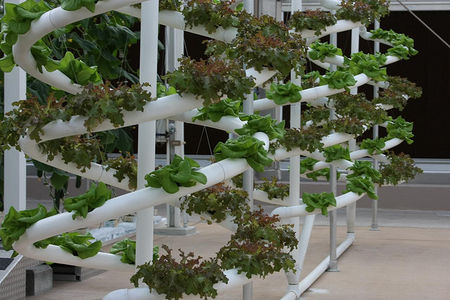Hydroponics
Main > Food and Agriculture > Controlled-environment growing
Hydroponics is the practice of growing plants in nutrient-enriched water rather than soil.
Hydroponics is incredibly productive and requires little space. For example, Factor e Farm's experiments found that they could grow $1 of lettuce per square foot per week. And the Institute of Simplified Hydroponics has found that they can grow 2kg of vegetables a day on 20m2 of space [1]. Indoor growing in a greenhouse greatly reduces losses to pests.
There are 6 main techniques used in hydroponics. The Drip hydroponics system continuously drips nutrient solution onto the plants roots. The Ebb and Flow (Flood and Drain) system floods the grow bed and hydroponics growing medium with a nutrient solution, then this solution slow drains back to the reservoir. Roots benefit from these periods of wetness and dryness. Deep Water Culture simply submerges roots in a nutrient solution. Less common hydroponics systems include the Wick System (where a fabric material wicks nutrient solution from the reservoir up to the roots), Nutrient Film Technique (where nutrient solution runs down long channels or tubes and passes over bare roots), and Aeroponics (where nutrients are administered via misting suspended and bare-rooted plants).
See here for free instructions on building several different hydroponic systems. N55 have a design for a vertical hydroponic system here. See Wikipedia on hydroponics for more information.
Open source software for automating hydroponic systems.
Aquaponics is a kind of hydroponics that uses the water from fish tanks. This eliminates the need for an input of nutrients. Also possible is to use containers filled with soil, stacked on top of each other.
Open-source hydroponic nutrient
You can mix hydroponic nutrient cheaply using mineral salts that most chemical suppliers have. The necessary ingredients are:
- Monopotassium phosphate (KH2PO4)
- Potassium nitrate (KNO3)
- Calcium nitrate (CaNO3)
- Magnesium sulfate (MgSO4)
- Boric Acid (H3BO3)
- Manganese chloride (MnCl2)
- Zinc sulfate (ZnSO4)
- Copper sulfate (CuSO4)
- Iron sulfate (FeSO4)
- Ammonium molybdate
Related OSE Wiki Pages
Links
- Hydroponics - Everything You Need To Know To Get Started, big messy 463-page book, covering everything: lighting, nutrients, suppliers, different plants and their requirements,
- How-To Hydroponics, 4th edition, a compact, practical book including plans for several systems
- http://www.hydroponicsonline.com/ An informative site. Also has forums.
- Captain Hydroponics Urban hydroponic designs and tips.
Open-source systems
- HAPI - An Open Source Project focused on building an automation platform, grow unit designs and educational materials
- general-purpose single-plant bucket drip system, CFL grow light cluster, simple deep-water culture systemfrom Jared Bouck's Inventgeek
- How-To Hydroponics kit plans
- Hydroponics free DIY plans
- Home hydroponic system, open-source plans for a vertically-stacked hydroponic system designed by n55
